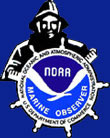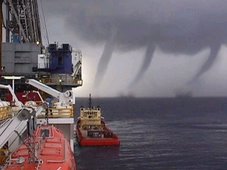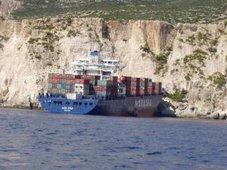 Early Warning System For Earthquakes: Seismic 'Stress Meter' Warned Of Earthquake 10 Hours In Advance
Early Warning System For Earthquakes: Seismic 'Stress Meter' Warned Of Earthquake 10 Hours In AdvanceScienceDaily (July 10, 2008) — Using remarkably sensitive new instruments, seismologists have detected minute geological changes that preceded small earthquakes along California's famed San Andreas Fault by as much as 10 hours. If follow-up tests show that the preseismic signal is pervasive, researchers say the method could form the basis of a robust early warning system for impending quakes.
"We're working with colleagues in China and Japan on follow-up studies to determine whether this physical response can be measured in other seismically active regions," said Rice University seismologist Fenglin Niu, the study's lead author. "Provided the effect is pervasive, we still need to learn more about the timing of the signals if we are to reliably use them to warn of impending quakes."
Today's state-of-the-art earthquake warning systems give only a few seconds' warning before a quake strikes. These systems detect P-waves, the fastest moving seismic waves released during a quake. Like a flash of lightning that arrives before a clap of thunder, the fast-moving P-waves precede slower moving but more destructive waves.
Findings from the new study indicate that the stresses measured by the new instruments precede the temblor itself, so a warning system using the new technology would be fundamentally different from current warning systems.
"Detecting stress changes before an earthquake has been the Holy Grail in earthquake seismology for years and has motivated our research," said study co-author Paul Silver of the Carnegie Institution of Science's Department of Terrestrial Magnetism. "Researchers have been trying to precisely and continuously measure these velocity changes for decades, but it has been possible only recently, with improved technology, to obtain the necessary precision and reliability."
In experiments near Parkfield, California, in late 2005 and early 2006, Niu, Silver and colleagues from Lawrence Berkeley National Laboratory (LBNL) gathered two months of measurements at the San Andreas Fault Observatory at Depth, or SAFOD, a deep well seismologists use to make direct measurements of the fault.
The team installed a high-precision seismic source made by a stack of donut-shaped piezoelectric ceramic cylinders that expand when voltage is applied -- a sophisticated device akin to a stereo speaker -- about one kilometer beneath the surface. At the same depth in an adjacent well, the scientists set up an accelerometer to measure the rhythmic signals from the source device.
When rocks are compressed, the stress forces air out of tiny cracks in the rock. This causes seismic waves to travel slightly faster through the rock. Niu said the variations are so slight they can be measured only with very precise instruments. For example, though the Parkfield instruments were more than a half mile below ground, the setup was sensitive enough to measure fluctuations in air pressure at the Earth's surface.
"Scientists tried as early as the 1970s to measure changes in wave speed that are associated with the stress changes that precede seismic activity," Niu said. "For a variety of reasons, their measurements were inconclusive. Using the precision instruments built by our collaborators at Lawrence Berkeley National Laboratory, along with new signal enhancement techniques, we were able to reach the fine level of precision required."
In analyzing the seismic data, Niu and colleagues found that a distinct change occurred in the rock before each of the minor earthquakes near Parkfield during the test period. A measurable change preceded a magnitude 3 quake on Christmas Eve 2005 by 10 hours. This was the largest local event during the observation period. A smaller but closer magnitude 1 temblor five days later was preceded by a signal about two hours before the quake.
Additional co-authors include Rice graduate student Xin Cheng and LBNL scientists Tom Daley and Ernest Majer. The research was supported by the National Science Foundation, Rice, the Carnegie Institution and LBNL.
WEATHER NOTE
2008 Lightning FatalitiesLightning deaths have occurred in 16 states. Ohio and South Carolina lead the nation with 2 fatalities.

CBS4 Hurricane Specialist Bryan Norcross Ends 20 Years Forecasting Hurricanes
Plans To Devote Time To New Business Enterprise
Chief Meteorologist David Bernard To Direct Storm Team
MIAMI (CBS4) ― He has helped South Floridians face hurricane season for nearly 2 decades, becoming a household word after people huddled in the dark with him as Hurricane Andrew blew down their homes around them. But now, CBS4 Hurricane Specialist Bryan Norcross has made the decision to step away from round-the-clock coverage in the event a hurricane threatens to focus on a new business he hopes will make all Floridians safer if disaster strikes.MARITIME NOTE
Port of New Orleans is formulating emergency plan
Posted by Jen DeGregorio, The Times-Picayune
July 10, 2008 5:00PM
After Hurricane Katrina wiped out electric controls and flood pump machinery at the Port of New Orleans, officials in charge of the cargo agency were left wondering whether better emergency planning could have prevented some of the storm's fallout.
The memory of Katrina's chaos has spurred the port to look more closely at its risk for future hurricanes and other disasters and to shore up facilities, which incurred nearly $250 million worth of damage during the storm. The analysis, which has been underway for more than six months, will ultimately take the shape of a formal hazard mitigation plan that would be the first of its kind for the Port of New Orleans. Although the port has protocols for disaster operations, officials have never before undertaken an inventory of its infrastructure or considered its chances for destruction during various types of emergencies.
In years past, hazard mitigation for the port was lumped in with overarching plans for Orleans Parish. But Katrina showed port officials that they needed more specific information than the summary provided in the New Orleans plan, said Deborah D. Keller, director of port development.
"We know it's going to generate ideas for projects" to protect the port, Keller said.
Scheduled for completion by the end of the year, the document will analyze data from the state and other sources to determine the port's penchant for different disaster scenarios, ranging from acts of terrorism to lightning. It will then outline steps for the port to fortify its assets from floods, fire and other catastrophes. Measures could be as simple as sealing windows or as complicated as repositioning power generators and controls.
Mitigation does not come cheap, and the port's plan could come with a hefty price tag. But with a formal report in place, the port would be eligible for mitigation funds from the Federal Emergency Management Agency.
Shenetia Henderson, a planner with the Governor's Office of Homeland Security and Emergency Preparedness, said there is no doubt that better planning could have minimized the consequences of Katrina at the port and around New Orleans. Since the storm, more local governments, universities and other entities have embarked on mitigation planning efforts.
Indeed, better planning could have prevented the levee breaches that caused the flooding of August 2005. The Army Corps of Engineers found that poor maintenance of levees as well as failure to build levees as part of an integrated system caused the tragic ruptures that destroyed so much of New Orleans.
"It's always good to plan," Henderson said.
The port held a public meeting Thursday to announce the planning process and seek comment about strategies for the mitigation plan, which can be submitted through Aug. 1. To qualify for federal mitigation funds, the port's plan needs approval from FEMA and the Governor's Office of Homeland Security and Emergency Preparedness.
Marine Safety Investigation Report - Final
Independent investigation into the near collision between the bulk carrier Ormiston and the roll-on/roll-off general cargo ship Searoad Mersey in Port Phillip, Victoria 16 May 2007
ABSTRACTAt about 0230 on 16 May 2007, the bulk carrier Ormiston sailed from Melbourne, Victoria, bound for Thevenard, South Australia. At about 0512, the ship rounded the Hovell Pile beacon and entered the South Channel in Port Phillip. At about 0521, Ormiston entered 'The Cut', the narrowest part of the channel, from the east making good about 15 knots.
At about 0230, the second mate on board the roll-on/roll-off general cargo ship Searoad Mersey contacted Point Lonsdale vessel traffic service (VTS) to provide an estimated time of arrival at the entrance to Port Phillip and was advised of the traffic movements within the port. At about 0420, Searoad Mersey's master, who also held a pilotage exemption for Port Phillip and had conducted over 1300 transits of the port, contacted VTS and received updated traffic information, including Ormiston's estimated movements.
At about 0435, Searoad Mersey passed Point Lonsdale lighthouse and entered Port Phillip. At about 0521, when the ship entered 'The Cut' from the west making good about 15 knots, the master had forgotten that Ormiston was approaching and did not see the approaching ship until immediately before the two ships passed. At about 0523, Searoad Mersey and Ormiston passed within 20 metres of each other in 'The Cut' at a combined speed of about 30 knots.
The ATSB investigation found that Searoad Mersey's bridge team members had not effectively implemented bridge resource management principles, were not keeping an adequate lookout and had lost situational awareness. The investigation also found that the ships did not communicate with each other until after the incident and that the Point Lonsdale VTS was not aware of the incident until after it had occurred.
The ATSB has issued four recommendations and one safety advisory notice to address the safety issues identified in the report.
Download complete report [PDF 1.9 MB]
OFF TO SEA WITH A SAILORS SKY.....
RS



































































































![Validate my RSS feed [Valid RSS]](valid-rss.png)